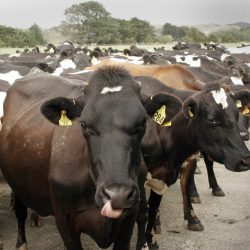Antibiotic Resistance And Our Role In Antibiotic Stewardship (Farmers and Veterinarians)
adapted by Ross Woods
I have taken part of an article that Stephen Page wrote for Virbac for Veterinarians and have included mostly the dairy related pieces. Stephen Page is a consultant veterinary pharmacologist and toxicologist based in Australia. He has always been particularly interested in decision making, value of information and appropriate use of veterinary medicines, especially antimicrobial agents.
In veterinary medicine, antibiotics are used for three main reasons in production animals:

- therapeutic treatment of animals with clinical illness;
- whole herd treatment of a group of animals (i.e. illness in a minimum threshold proportion of animals triggers treatment of the entire herd)
- preventative treatment of a group of healthy animals considered at risk of developing clinical illness. Antibiotics are also an important therapeutic option in the treatment of clinical illness in companion animals
Antibiotic use could contribute to drug-resistant bacteria developing in animals. There is increasing concern that antibiotic resistance may pass from bacteria in animals to bacteria in people or that drug-resistant animal bacteria may infect people.
The continued overuse and misuse of antimicrobials (including antibiotics), in both humans and animals, could lead to the global death toll due to drug-resistant increasing significantly by 2050. Of particular concern is the development of resistance to antibiotics classified by the World Health Organization as being of greatest importance for human medicine.
Against this background, the rationale for minimising the development of antibiotic drug resistance in veterinary medicine is two-fold:
- to maintain the long-term effectiveness of currently available antibiotics, especially as new agents will likely be restricted to human medicine.
- to minimise the likelihood of transfer of antibiotic drug resistance between the bacteria of animals and humans
Agricultural antibiotic sales data is used to monitor trends that may indicate changes in antibiotic use in the field, which may inform changes in antibiotic resistance. Inferring antibiotic use from sales data does, however, come with inherent limitations due to variables such as the timing of data collection and antibiotic use, unquantified product loss, and changes in animal population and disease prevalence.
Sales data for antibiotics used in food-producing animals in NZ during the period 2011–14 indicate that the dairy cow, pig, and poultry industries purchased the greatest mass of antibiotics. Antibiotics are used in apparently healthy animals in NZ for prevention and whole herd treatment, e.g. in-feed antibiotics are used in the poultry industry, and on NZ dairy farms antibiotics are prescribed for mastitis prevention and treatment. In contrast, antibiotic sales in the other food-producing animals, sheep, beef cattle, and deer, appear to be very low.
In a study that estimated the use of antibiotics for food-producing animals in Australia, NZ, Canada, the US, and twenty-six European countries in 2012, NZ was the third lowest user of antibiotics in production animals. The relatively low usage of antibiotics in production animals in NZ is at least partially attributable to NZ’s extensive pastoral, and therefore less intensive, agricultural systems as well as its relatively small pig and poultry industries.
The greatest use of antibiotics in the dairy industry is for dairy cow mastitis and in particular dry cow therapy, with entire herds being treated preventatively in many cases. However, increasingly there have been calls for use of antibiotics in dairy cows only as a treatment where there is clear evidence of infection. Consistent with this trend, and recognising that there are now effective alternatives to dry cow antibiotic therapy (e.g. internal teat sealants and better herd management practices), the NZVA has proposed that, by 2020, dry cow therapy will only be used in the treatment of existing intramammary infections.
There are three ways to reduce the use of antibiotics:
- Reduce the number of animals needing treatment with antibiotics via improved integrated herd management, disease prevention, and use of non-antibiotic alternative treatments.
- More prudent use of antibiotics, i.e. treating known disease only and not treating the herd preventatively.
- Reducing the duration of antibiotic therapy, since total mass of antibiotic used = dose x duration of treatment x mass of animals treated x number of animals treated.
NZVA’s Guidelines for the Judicious Use of Antimicrobials in Dairy Cows
- All dairy farmers and their vets must be committed to producing safe food.
- Dairy farms should be managed to reduce the risk of disease challenge and, therefore, the need to use antibiotics.
- Dairy farmers and their vets should draw up, implement, and regularly review an appropriate herd health plan that outlines routine preventive treatments (e.g. biosecurity, vaccination programmes, etc) and disease control policy.
- Antibiotics should only be prescribed by a vet when there is evidence of a susceptible bacterial infection, treatment is necessary to maintain animal health and welfare, and no other treatment such as drainage or antisepsis is likely to be effective. Treatment should be restricted to individual animals where possible.
- Choice of antibiotic should be based on knowledge of common pathogens and local laboratory data.
- Antibiotics and dose regimens should be chosen to minimise the development of clinically significant resistance in people or animals.
- An appropriate withholding time must be applied before the slaughter of treated animals or inclusion of milk from treated cows to the bulk milk tank.
- Accurate information must be kept on the identity of the treated cattle, the nature of the condition being treated, drugs used, and withholding period.


